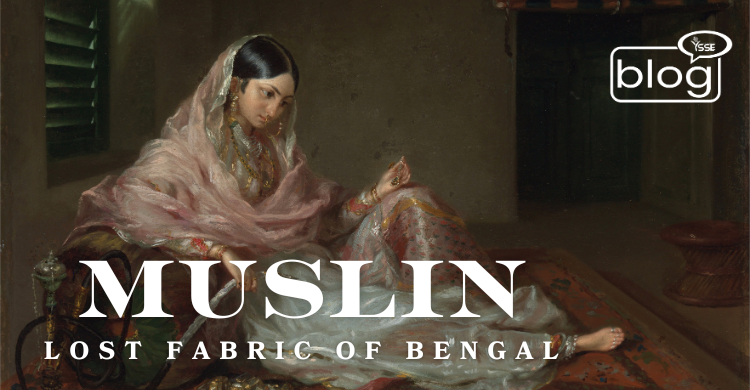Bengalis produced the greatest fabric in the history of mankind, but it was tragically lost as a result of colonialism and economic disaster under the rule of Britain.
A little over 200 years ago, Dhaka muslin was arguably the most precious cloth in the world. Then things got completely lost.
How did this occur? Can anybody bring it back?
Dhaka muslin was a costly cloth brought from the same-named city in what is now Bangladesh but was once in Bengal. It didn’t feel like the muslin used now. The textile, made in an intricate 16-step process with rare cotton grown solely along the shores of the sacred Meghna River, was regarded as one of the period’s greatest jewels.
Characteristics
Muslin is a knitted cotton fabric that used to be regarded as a premium fabric. Jamdani, the original kind of muslin, was typically brilliantly colored and striped while remaining lightweight and practically transparent.
Duarte Barbosa, a Portuguese explorer, described Bangladeshi music in the 16th century. He described several other sorts of cloth, including ‘estrabante’ (sarband), ‘mamona’, ‘fugoza’, ‘choutara’, and ‘sinabaka’.
Bengali muslin was exported across the Muslim world, including the Middle East and Southeast Asia. Several Islamic nations, including Central Asia, dubbed the textile Daka from the town of Dhaka.
Legacy
Muslin has been used for centuries. The Nawabs of Bengal commonly utilized muslin. Bengal’s first Nawab, Murshid Quli Khan, would present muslin to the ruling Mughal Emperor. In the summertime, the Emperors opted for Malma Khash muslin, as did the Nawab’s Badshah and Amirs. Muslin’s popularity increased significantly throughout the Mughal period, thanks to Empress Nurjahan. She chose muslin for the royal harem.
Muslin was frequently utilized by Europeans for making elegant shirts, skirts, underwear, and children’s apparel. Josephine Bonaparte was notably depicted in a semi-sheer muslin robe. Noble ladies frequently moistened their muslin clothes to highlight their hips, and other features of their anatomy stood out.
French fashion dominated Europe’s luxury league tables. It was primarily centered on silk until muslin superseded it, particularly with the encouragement of Monarch Mary Antoinette and Emperor Josephine Bonaparte.
Weavering Process
Textile artisans in Dhaka, Bangladesh, utilized a method known as “discontinuous weaving” to create this extraordinarily delicate cloth. This method required the weaver to construct two weft layers, one as fine as spider silk to bind the fabric altogether and the other to create the design. Each embroidery motif was stitched manually, with fine bamboo filaments interlacing the embroidery threads with the weft threads.
Unsurprisingly, this type of fabric was so valuable because it was labor-intensive and required skill and patience.
Decline and British Scheming
Unfortunately, during the reign of the East India Company, they demolished the traditional business of Bengal. British-made factory-produced clothes became an alternative to Muslin. Jamdani Muslin became unprofitable as a result of harsh taxes on locally-made textiles and the breakdown of local and prominent patrons. The expertise was nearly lost.
Under British imperial supremacy in the 18th century, the indigenous Bengali muslin production was brutally crushed by a variety of colonial schemes that favored imported industrially produced textiles from Britain.
In 1772, William Bolts, a renowned merchant, claimed that “thumbs had been chopped off” to limit the fabrication of muslin. As a consequence, the standard of muslin declined significantly, and its elegance was almost completely lost.
Revival
A Bangladeshi study team made six muslin sarees and gave one to the Prime Minister. Nevertheless, the task has not been easy. To have a better understanding of the famed fabric, the crew traveled around Bangladesh, India, and finally London.
After six hard months, many additional improvisations, and numerous broken threads, the team had created a 300-threaded sari, which was considerably lower than that first Dhaka muslin standard but far greater than any weaver had managed in years.
Global Recognition
Dhakai Muslin was accepted as an authorized GI brand in 2018, due to government officials and cultural enthusiasts in Bangladesh.
Thankfully, some firms from Bangladesh nowadays assist local artisans to continue their craft. With the inclusion of Jamdani Muslin on UNESCO’s Heritage List of the Intangible Cultural Assets of Humanity, there is an additional motive to continue production, albeit on a limited scale.
Given the higher rate of trade in mass-made and synthetic materials in the bazaar today, it is critical that these historical talents are not lost permanently. No machine can ever match the excellence produced by a trained artisan. Their abilities constitute an aspect of our textile heritage, and it’s great that they’re acknowledged and protected.
To read these types of blogs, please visit here.
Writer,
Sadi Reza,
Intern at Content Writing,
Youth School for Social Entrepreneurs.

